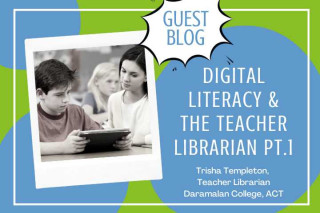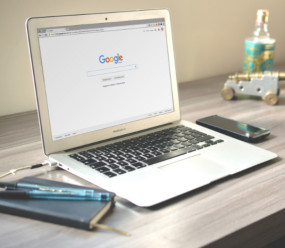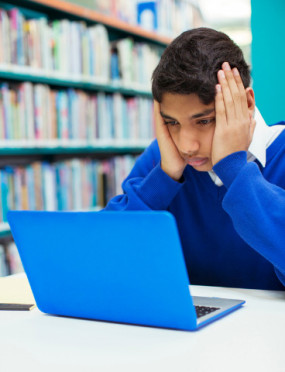- Your School Type
- Solutions
- Resources
- Blog
- Events
- More
- Contact Us
- Book a Demo
- Get a Quote

For this 2-part guest blog, we are delighted to welcome Trisha Templeton, Teacher Librarian at Daramalan College, ACT. In part one, Trisha discusses the impacts of poor digital literacy. In part two, Trisha explores the role of the teacher librarian in developing digital literacy.
The world’s economy has evolved with the transfer from production lines to one structured upon the creation and dissemination of information. This era has been revolutionised by the ubiquitous presence of the internet and the speed in which it is generated. Combined with rapidly evolving technology; access, use and production of information is easier. The education sector has been particularly affected by this insurgence of documentation and the skill sets required to seek, harness and use information successfully. This essay will define digital literacy and its pivotal role in information seeking behaviour trend of adolescents, its impact on educational practices and the role of the teacher librarian in this knowledge society.
Literacy has evolved from simply being able to read and write in text form into something more dynamic. ACARA (2016a) has expanded the definition to include; the ability to interact with, engage and use language across modalities for a variety of purposes and a diversity of contexts. In this knowledge rich society, information is available in multiple formats and can be often simultaneously engaged with (Jacobson et al., 2018). Therefore, digital literacy (DL) is the ability to appreciate the need for; the expertise to access; the capacity to evaluate, use and integrate information within the school environment and in general society (Lofton, 2016). Thomas et al. (2018) acknowledge, even though access is widespread, individuals are grappling with the ability to use the new technologies in all areas of life (p.12).
The modern student is heavily reliant upon the internet for both information seeking and retrieval due to the widespread availability of mobile devices (McGrew et al., 2018, Mussell & Croft, 2013, Lanning & Mallek, 2017; Mills & Angnakoon, 2015). Teachers are often frustrated at student’s poor information seeking behaviour (ISB) and vexed by their blind dedication to Google and Wikipedia, despite a lifetime exposure to technology (Saunders et al., 2017). The exasperation tends to peak at the student’s inability to successfully identify relevant and reliable resources online. Unlike a library, where the librarian acts like a gatekeeper, the internet and thus everything on there, including unsubstantiated and vitriolic materials, are freely accessible.
Search engines are the most common starting point as students are familiar with their visual design, their mechanism and are viewed as fast and reliable (Lanning & Mallek, 2017; Qayyum & Smith, 2018 and Mussell & Croft, 2013). Adolescents often base their entire study upon the virtue of Wikipedia and Google (Ricautre, 2016; Qayyum & Smith 2018). Wikipedia, as Ricautre (2016) elaborates, is built upon the concept of crowd-sourcing, as the public is encouraged to contribute information. Whilst understandably these parameters allow for open dialogue and the precept of an open learning environment, it brings validity and accuracy of information presented into disrepute.

Google is an omnipresent search engine in modern society. Its pervasive presence has led to ‘google it’ often replacing ‘search for it’ in modern jargon. Regrettably, as McGrew et al., (2018) point out, students determine the usefulness of a website based upon superficial points, such as the hierarchy of results displayed by Google. Students fail to comprehend that Google, a corporation, controls results based upon an algorithm determined by the user’s own personal digital history (Ricautre, 2016). In this way, Google ensures that the search results match closely to the user’s state of mind, previous search parameters and thus is more likely to be accepted (Ricautre 2016). Some students do not even open up the individual sources but rather just peruse the content on the main search page and accept the information as correct without understanding context (Russell & Callegaro, 2019). Other students rarely venture away from the initial website due to insufficient DL skills, so they accept information without verifying authenticity and or bias (McGrew et al., 2018). This creates a moral dilemma as they are willingly restricting access to information simply because it is easier.
The problems with students’ ISB are numerous. Firstly, their techniques used to seek information are based most often on predetermined algorithms, ineffective search terms and minimum effort expended. In order to cope with the overload of information available, students covertly reduce their search techniques so as to minimize the amount they are presented with (Qayyum & Smith, 2018). Russell & Callegaro, (2019) point out correctly, that students place the whole query into the search bar and expect a complete response instantly, as there is an unwillingness to construct a bank of knowledge (Mussell & Croft 2013). Qayyum & Smith (2018) corroborate, by suggesting that the speed in which the internet produces results prevents reflection of content. The DL skills of skimming and scanning cannot keep up with the flow of information and sources are rejected if not exactly correct.

Kobayashi (2018) found that whilst students preferred engaging with technology, they are unwilling to use advanced software and hardware, as they are unable to troubleshoot. This self-censorship is due to an inability to interpret multimodal sources with a rich media presence (Head et al., 2018, p.4, Jacobson et al 2018; Kobayashi, 2018). This is especially true for students, who already have low literacy, as they often get overwhelmed by embedded multimedia, slowing comprehension (Kobayashi, 2018). Other students find the layering of sources distracting which also slows cognition down. The majority of adolescents are unable to use search terms properly and when faced with an overwhelming number of sources, they simply use the first few and disregard the rest, despite the possibility of their importance (Mussell & Croft, 2013). Their ability to navigate the internet is hampered by a lack of literacy and critical thinking skills.
Once students have managed to find sources they understand, they are unable to determine veracity. McGrew et al., (2018), in their study, concluded that the pattern in which students investigate the reliability of a website is mainly determined by the visual appeal and seemingly professional appearance, whilst often disregarding the bias and or dubious authorship. Jacobson et al (2018) argued that students are receptive to emotive language and the presence of speculative data was used as evidence of reliability (McGrew et al 2018). Students will also accept the reliability of sources if they subconsciously agree with the information and disregard sources that they disagree with, due to the challenges this new data imposes upon them (Jacobson et al 2018 and Russell & Callegaro 2019). Even when presented with alternate sources, like databases, many preferred search engines due to the visual appeal and navigation ease (Lanning & Mallek, 2017, and Mussell & Croft, 2013). Shenton (2018) attributes this literacy to, in that students with lower literacy are often unable to decode more complex text and use familiarity of structure to determine reliability and rationality. In terms of DL, this ISB highlights a lack of critical thinking skills, as accessibility is preferred over validity, which is a significant issue for education and beyond.
The presence of the internet has forever changed how public policy and societal issues are addressed, and it is imperative that students are proficient at ISB so that they can do the same hereafter (McGrew et al., 2018 and Thomas et al., 2018). DL is a citizenship issue and true democratic societies require the voter to be able to find reliable information, evaluate multiple perspectives and communicate their ideas on current issues (McGrew et al., 2018; Jacobson et al., 2018). If students are incapable of DL at school when investigating tasks simple and direct, then their ability to navigate for information on more controversial topics is hampered (McGrew et al., 2018). This is particularly evident in an election year when society is bombarded multi-modally in an effort to persuade the voter. If one is unable to filter, understand and evaluate the information effectively, then the scope of information is greatly narrowed. One only has to look at the media about the upcoming federal election to realise how important DL is within society.
To learn more about the role of the Teacher Librarian in developing digital literacy, read part 2 of this series.
ACARA. (2016a). National literacy learning continuum. Australian Curriculum. https://www.australiancurriculum.edu.au/resources/national-literacy-and-numeracy-learning-progressions/national-literacy-learning-progression/what-is-literacy/
ACARA. (2016b). NAPLAN online. National Assessment Program. https://www.nap.edu.au/online-assessment
ACCC. (n.d.). Nigerian Scams. Scamwatch. Retrieved from https://www.scamwatch.gov.au/types-of-scams/unexpected-money/nigerian-scams
ACT Government. (n.d.) School Libraries: The heart of 21st century learning. Education Directorate. Retrieved from https://www.education.act.gov.au/__data/assets/pdf_file/0020/916301/School-Libraries-21st-Century.pdf
ALIA. (2015). Australian Library and Information Association Minimum Standard Guidelines for Library Services to Prisoners. Retrieved from https://www.alia.org.au/about-alia/policies-and-guidelines/alia-policies/prison-guidelines
ALIA and ASLA. (2016). Statement on Teacher Librarians in Australia. Retrieved from https://asla.org.au/resources/Documents/Website%20Documents/Policies/policy_tls_in_australia.pdf
Berg, C., Malvey, D., and Donohue, M. (2018). Without foundations, we can’t build: Information literacy and the need for strong library programs. In the Library with the Lead pipe. http://www.inthelibrarywiththeleadpipe.org/2018/strong-school-library-programs/
Bevan, C. (1984). Minimum standard guidelines for Australian prisons 1978, Australian Institute of Criminology. https://aic.gov.au/publications/archive/min-standard-guidelines-prisons
Curriculum Corporation, Australian School Library Association and Australian Library and Information Association (2001). Learning for the future: developing information services in schools (2nd ed). Curriculum Corporation, Carlton South, Vic. pp60-62
Department of Industry, Innovation and Science. (2016). Australia's digital economy update. https://apo.org.au/sites/default/files/resource-files/2016/05/apo-nid66202-1210631.pdf
El-Khayat, Y. (2016). Librarians help high school students improve research skills. Journal of Medical Library Association. 104:3. DOI 10.3163/1536-5050.104.3.009
Head, A., Wihbey, J., Metaxas, P., MacMillan, M., and Cohen, D. (2018). How students engage with news. Five takeaways for educators, journalists and librarians. Project Information Literacy Research Institute. http://www.projectinfolit.org/uploads/2/7/5/4/27541717/newsreport.pdf
Jacobsen, R., Halvorsen, A., Frasier, A., Schmitt, A., Crocco, M., and Segall, A. (2018). Thinking deeply, thinking emotionally; how high school students make sense of evidence. Theory & Research in Social Education. 46:232-276. DOI 10.1080/00933104.2018.1425170
Lamb, A. (2011). Bursting with potential: Mixing a media specialist's palette. Techtrends : Linking Research & Practice To Improve Learning, 55(4), 27-36.
Lanning, S,. and Mallek, J. (2017). Factors influencing information literacy competency of college students. The Journal of Academic Librarianship. 43: 443-450. DOI: 10.10.16/j.acalib.2017.07.005
Lofton, J. (2016). Students are makers! Building information literacy skills through makerspace programs. CSLA Journal. 40 (2). https://www.questia.com/magazine/1P3-4305515741/students-are-makers-building-information-literacy
Kachel, D. (2015). The calamity of the disappearing school libraries. {Blog Post} Theconversation.com. https://theconversation.com/the-calamity-of-the-disappearing-school-libraries-44498
Kobayashi, M. (2017). Student’s media preferences in online learning. Turkish Online Journal of Distance Education. 18:3. ISSN 1302-6488. https://eric.ed.gov/?id=EJ1147585
McGrew, S., Breakstone, J., Ortega, T., Smith, M., and Wineburg, S. (2018). Can students evaluate online sources? Learning from assessments of civic online reasoning. Theory & Research in Social Education. 46: 165-193. DOI 10.1080/00933104.2017.1416320
Miller, S. (2018). Diving deep; Reflective questions for identifying tacit disciplinary information literacy knowledge practices, dispositions and values through the ACRL framework for information literacy. The Journal of Academic Librarianship. 44: 412-418. DOI: 10.1016/j.acalib.2018.02.014
Mills, L., and Angnakoon, P. (2015). How do high school students prefer to learn? CELDA 2015. https://files.eric.ed.gov/fulltext/ED562093.pdf
Mussell, J., and Croft, R. (2013). Discovery layers and the distance student: online search habits of students. Journal of Library and Information Services in Distance Learning. 7:1-2, 18-39, DOI 10.1080/1533290X.2012.705561
Nickpour, F. (2017). Information Behaviour in design; a conceptual framework. Design, User Experience, and Usability: Theory, Methodology, and Management. pp 152-162. DOI: 10.1007/978-3-319-88634-2_12
OÇonnell, J. (2017). School Libraries. In I.Abdullahi (Ed) Global library and information science: A textbook for students and educators. Berlin, Boston; De Gruyter Saur. https://heyjude.files.wordpress.com/2017/11/ifla-174_16_o-connell.pdf
Office of Australian Information Commissioner. (n.d.) Freedom of Information Act 1982. https://www.oaic.gov.au/freedom-of-information/foi-act
Qayyum, M., and Smith, David. (2018). Changing research behaviours of university students with progression through a course. Journal of the Australian Library and Information Association. Vol 67: 3 pp256-277 DOI: 10.1080/24750158.2018.1502243
Ricaurte, P. (2016). Pedagogies for the open knowledge society. International Journal of Educational Technology in Higher Education. 13:32 DOI: 10.1186/s41239-016-0033-y
Russell, D., and Callegaro, M. (2019, March 26) How to be a better web searcher: secrets from Google scientists. Scientific American https://blogs.scientificamerican.com/observations/how-to-be-a-better-web-searcher-secrets-from-google-scientists/
Saunders, L., Severyn, J., and Caron, J. (2017). Don’t they teach that in high school? Examining the high school to college information literacy gap. Library & Information Science Research. 39: 276-283. DOI 10.1016/j.lisr.2017.11.006
Shenton, A. (2018). Reading in information behaviour and information literacy frameworks. Collection and Curation. 37:2. Pp6-64. DOI 10.1108/CC-04-2017-0013
Thomas, J., Barraket, J., Wilson, C., Cook, K., Louie, Y., Holcombe-James, I., Ewing, S., and MacDonald, T. (2018). Measuring Australia’s Digital Divide: The Australian Digital Inclusion Index 2018. RMIT University, Melbourne, DOI: https://doi.org/10.25916/5b594e4475a00
United Nations. (1948). Human Rights Charter. https://www.un.org/en/universal-declaration-human-rights/
Wood, P. (2017). School libraries disappearing as as the digital age is over. ABC News. Retrieved from https://www.abc.net.au/news/2017-09-25/school-libraries-disappearing-as-the-digital-age-takes-over/8980464